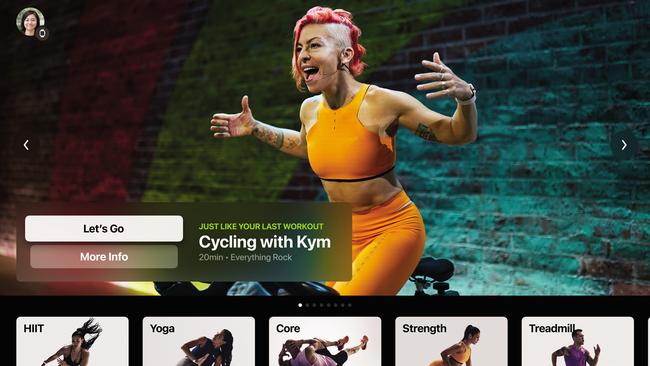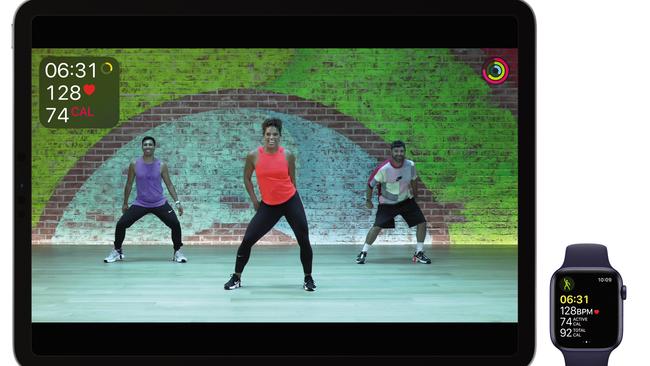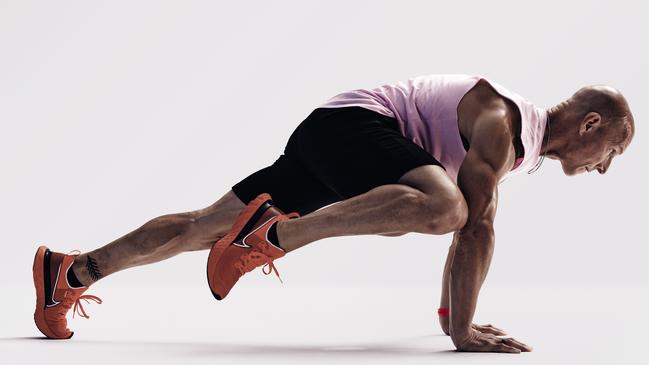Apple’s Fitness+ app brings the latest tech to your workout
Apple’s imminent Fitness+ release could become a category killer for workout apps.

Can personal technology actually make you fitter? Apple certainly thinks so. The company is about to launch its Fitness+ service, which it announced in September, in Australia, Canada, Ireland, New Zealand, the UK, and the US. It’s a play for a share of the burgeoning global $US3bn ($4.04bn) fitness app industry — an industry that is expected to be worth as much as $16bn by 2026, according to a Polaris Market Research report
The service, which has been more than five years in development, is being spearheaded by Jay Blahnik, Apple’s senior director of fitness and health technologies. Blahnik is a globally recognised and widely published fitness expert who, prior to working for Apple, spent 20 years as a contract athlete and consultant with Nike and worked closely with the company on its popular Run Club app.
He was also the original creator and program developer of the Nike Training Club app, which currently has more than 25 million users and was a key consultant with the footwear and sportswear company on the development of the Nike+ Fuelband.
So, he is well versed in the intersection between technology and fitness — and, specifically, how new technologies can actually improve a user’s fitness.
“I think technology has fundamentally changed how people get and stay fit,” Blahnik says.
And while he agrees that the cellular structure of the human body hasn’t changed since the invention of the smartphone, the way wearable technology can measure fitness levels, set personal goals and celebrate achievements is where tech can actually make it easier for someone to be motivated to exercise.

“The thing that technology does is that it changes behaviour,” he says. “I firmly believe it’s hard to motivate someone to do something that they don’t want to do. But one of the single best ways to get them to do it is to make it easier than it was before. So, an example would be, maybe someone doesn’t want to run or take up a gym membership, but they do want to be more active. Well, with the activity rings on Apple Watch we’ve broken it down to give you a whole day to close the rings, so you don’t have to do a whole workout session, we’ll measure it across the entire day — and what that does is it reduces the friction to be a little more active.”
Perhaps even more significant than being a timepiece, Apple Watch is a health and wellness device that in addition to measuring a wearer’s activity throughout the day can also measure heart rate, blood oxygen levels and sleep patterns. A key function of the watch is its so-called activity rings which measure movement (how many active calories you’ve burned), exercise (how many minutes of brisk activity or workouts you’ve done) and standing (how many times in the day you’ve stood and moved for at least one minute per hour). A user can set how much of each activity they want to achieve in a day and as they close each ring they get a visual celebration on their watch — the goal being to close all three rings each day.

Fitness+ is a subscription workout service for Apple Watch users (Fitness+ requires an Apple Watch Series 3 or later paired with an iPhone 6s or later, or iPhone SE). There are thousands of fitness apps on the Apple App Store, and while the company insists its new Fitness+ service is a complement to existing apps, if it’s successful it could very well be a category killer given the sheer number of Apple Watch owners.
Smartwatch sales do not seem to have been adversely affected by COVID-19, with sales growing by 20 per cent this year, according to Counterpoint Research. The Apple Watch is the world’s biggest-selling connected device accounting for more than 51.4 per cent of all smartwatch sales, according to the report.
Apple doesn’t break out sales of its individual products, but its wearables category — which includes Watch, AirPods and HomePod — grew by 25 per cent in 2020 with sales of $US30.6bn. According to some analysts, Apple now sells more watches than the entire Swiss watch industry.

The service is also competitively priced. Fitness+ is $14.99 per month, or $119.99 per year. It’s available on a free trial for one month, and customers who purchase a subscription can share it with up to five other people in their family with the Family Sharing function. Sweat, founded by the Adelaide-based Kayla Itsines, is about the same price for a single user. Centr, Chris Hemsworth’s fitness app, is also similarly priced for a single user.
On top of price, one of the key distinguishing factors of Fitness+ is its seamless integration with the measurement and fitness data produced by a user’s Apple Watch.
“I do believe measurement leads to motivation when it comes to fitness,” Blahnik says. “Measurement can be turned almost into a currency that allows you to say, ‘hey, I’ve only ever done this workout three days in a row, now I’m going to try for a fourth day’. It allows you to create rewards, milestones and celebrations. What I love about what technology has done for fitness is, absent of still needing to do the lunges and squats and running or whatever, is to not have to rely on your memory for what you’ve done and to actually take a look at how what you’ve done adds up over time. You can see how you’re improving, or if you’re falling behind.”

Fitness+ is a service that’s designed to help Apple Watch owners keep fit through a series of guided workouts across multiple categories. At launch, workout types include cycling, rowing, treadmill, HIIT, strength, yoga, dance, core and mindful cool down. The workouts are led by a group of experienced trainers who have been recruited from all over the world — including Dustin Brown, a yoga teacher from Melbourne — and produced in a studio in Los Angeles. The trainers are from a diverse range of backgrounds and ages — including one trainer, Molly Fox, who is in her 60s.
Using a custom recommendation engine, Fitness+ considers previously completed workouts and suggests new options that match the workouts users select most often, or something new to balance their current routine.
Customers can also use a filtering tool to choose what is most important to them when looking for a workout, whether it’s the workout type, the trainer, the duration, or the music. Workouts can be as short as 10 minutes and as long as 45 minutes.
When a workout is selected and started on iPhone, iPad, or Apple TV, the correct workout type will automatically start on Apple Watch. During the session, the metrics from Apple Watch are shown on the screen and come to life for moments of inspiration. For example, when the trainer says to check heart rate, or begins a countdown timer, those numbers will animate on the screen. And for users who like to push themselves, the optional Burn Bar shows how their current effort stacks up against anyone who has done the same workout previously.
“We have put a big emphasis on the trainer team and the notion of really inviting everyone to the party,” Blahnik says. “We wanted to make sure the trainers are welcoming, the exercises are accommodating and there are modifications in every workout (to make it easier or more challenging) and there is a real feeling inside the system that regardless of what level you’re at, this is a place where you can feel safe to get started and to make fitness a part of your life.”
Working — and working out — at home has been one of the defining trends of the pandemic, but Blahnik insists the development of the Fitness+ app was not a response to the current health crisis.
“We’ve really been working on it for many years, and from the beginning we really wanted people to be able to experience this in whatever places and spaces they want to work out. The way we built this, even before COVID, we could tell that many people would want to use this solely at home or when they travel. If we only wanted it to be for home exercise, we probably wouldn’t have added rowing and cycling and treadmill because we know that not a lot of people have all those pieces of equipment at home.”

A study from Rutgers University published in the Journal of Sports Medicine and Physical Fitness in April last year found that HIIT, or high intensity interval training, while effective in improving cardiorespiratory fitness, boosting energy and promoting lean muscle mass and fat loss, also increases injury risk, especially in the knees and shoulders. The difference with doing a physical HIIT class over a virtual one is that a trainer can see what you’re doing wrong and correct you to avoid injury. Obviously, that doesn’t happen with a virtual class and it’s a factor that influenced the design of the Fitness+ HIIT workouts, says Blahnik.
“The trainers are not just creating their workout and going out and filming them — there’s a lot of vetting happening,” he says. “They bring it to the programming team, they rehearse it … and then we look at the exercise and think is it easy to make it hard and is it easy to make it easy? Is the exercise easily adaptable? And we always have a modifier showing you on screen how to adapt it. Often what you see in fitness classes is the only way to do an exercise (and) is really high impact — it’s double to nothing. But even in the treadmill classes, there is always a runner and a walker there.
One of the biggest challenges to sustaining a fitness regimen in the long term is staying motivated. According to Blahnik, it’s the reason the Fitness+ service will have a mix of short and longer workouts. “I think for a lot of people they jump in headfirst and say they are going to do an hour and a half every day and that’s just too much to sustain. Having access to short workouts is important for having variety. It’s a big commitment to sign up to a gym and dedicate the time to do classes. One simple way to get people to change their habits is to start small, and technology allows you to do that.”








To join the conversation, please log in. Don't have an account? Register
Join the conversation, you are commenting as Logout